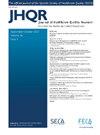Healthcare-associated infections in a long-term care hospital: A three-year point-prevalence study
IF 1
Q4 HEALTH CARE SCIENCES & SERVICES
引用次数: 0
Abstract
Objective
To assess the prevalence of Healthcare-Associated Infections (HAIs) acquired during hospitalization in a long-term care (LTC) hospital during three periods and identify associated factors.
Methods
An observational, cross-sectional study had been conducted in 2019, 2021, and 2023 that included 380 patients. Data collected encompassed demographics, presence of risk factors (pressure sores, catheters, surgery), and HAIs acquired in the current hospitalization. Global and per location HAI was determined, and bivariate and a multiple logistic regression model was constructed to explore the association between the studied variables and infection.
Results
The median age varied depending on the year of the survey between 77 and 80.5 years, and the proportion of female patients increased each edition. Length of stay peaked in 2021 (43.5 days), and risk factors in 2023. HAIs prevalences were 8.4% (2019), 10.7% (2021), and 5.6% (2023). Respiratory tract infection was the most frequent globally (34.4%), in 2019 (35.7%) and 2023 (50.0%), followed by urinary tract infection. Globally, HAI and any risk factor (OR: 3.8, 95% CI: 1.6–8.8), and pressure sores (OR: 2.4, 95% CI: 1.1–5.2) were associated, this last remained after adjustment (OR: 16.0, 95% CI: 2.5–104.9).
Conclusions
LTC hospitals pose a risk for HAI. Further research on associated factors and preventive strategies is crucial to improve care in this sector.
长期护理医院的医疗保健相关感染:一项为期三年的点流行研究
目的评估某长期护理医院住院期间获得性卫生保健相关感染(HAIs)的流行情况,并确定相关因素。方法于2019年、2021年和2023年进行了一项观察性横断面研究,包括380例患者。收集的数据包括人口统计、风险因素(压疮、导尿管、手术)的存在以及当前住院期间获得的卫生保健指数。确定了全球和每个地点的HAI,并构建了双变量和多元逻辑回归模型,以探讨所研究变量与感染之间的关系。结果不同年份患者年龄中位数在77 ~ 80.5岁之间,女性患者所占比例逐年增加。停留时间在2021年达到峰值(43.5天),风险因素在2023年达到峰值。HAIs患病率分别为8.4%(2019年)、10.7%(2021年)和5.6%(2023年)。全球最常见的是呼吸道感染(34.4%),2019年(35.7%)和2023年(50.0%),其次是尿路感染。总体而言,HAI与任何危险因素(OR: 3.8, 95% CI: 1.6-8.8)和压疮(OR: 2.4, 95% CI: 1.1-5.2)相关,最后一个因素在调整后仍然存在(OR: 16.0, 95% CI: 2.5-104.9)。结论sltc医院存在HAI风险。进一步研究相关因素和预防战略对于改善这一部门的护理至关重要。
本文章由计算机程序翻译,如有差异,请以英文原文为准。
求助全文
约1分钟内获得全文
求助全文
来源期刊

Journal of Healthcare Quality Research
Medicine-Health Policy
CiteScore
1.70
自引率
8.30%
发文量
83
审稿时长
57 days
期刊介绍:
Revista de Calidad Asistencial (Quality Healthcare) (RCA) is the official Journal of the Spanish Society of Quality Healthcare (Sociedad Española de Calidad Asistencial) (SECA) and is a tool for the dissemination of knowledge and reflection for the quality management of health services in Primary Care, as well as in Hospitals. It publishes articles associated with any aspect of research in the field of public health and health administration, including health education, epidemiology, medical statistics, health information, health economics, quality management, and health policies. The Journal publishes 6 issues, exclusively in electronic format. The Journal publishes, in Spanish, Original works, Special and Review Articles, as well as other sections. Articles are subjected to a rigorous, double blind, review process (peer review)
 求助内容:
求助内容: 应助结果提醒方式:
应助结果提醒方式:


